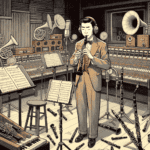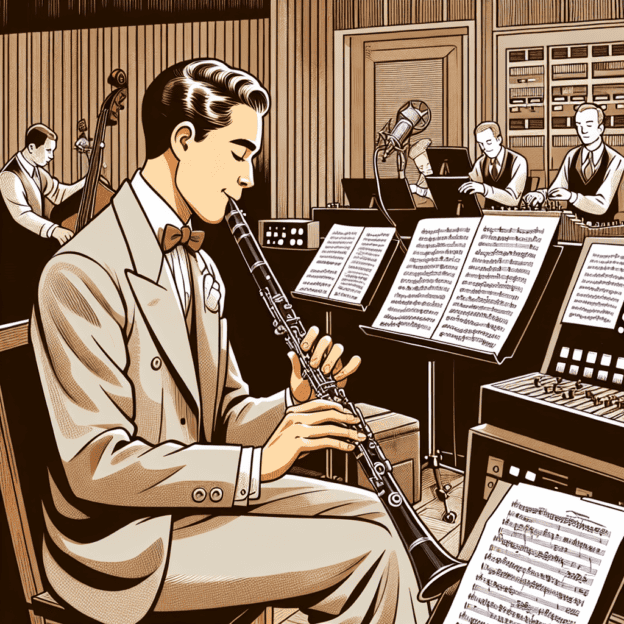The clarinet has played a significant role in film music since the early days of cinema. Known for its expressive sound, the clarinet adds a distinctive flavor to orchestral arrangements, making it a popular choice among composers and film directors. Throughout film music history, the clarinet has contributed emotion and depth to countless scores, helping filmmakers create powerful feelings and enhance their storytelling.
The Clarinet's Characteristic Voice
The clarinet stands out for its wide range and unique sound. It can create warm, mellow tones and bright, piercing notes, making it suitable for various musical styles. This flexibility has made the clarinet a key instrument in film scoring, where expressing emotions is crucial.
From its low, rich notes to its high, clear tones, the clarinet can express many feelings, smoothly shifting from gentle lullabies to exciting action sequences. This adaptability makes it important in both large orchestras and smaller groups.
Clarinet Range and Characteristics
| Register | Sound Quality | Typical Use in Film Music |
|---|---|---|
| Low | Rich, dark, mysterious | Suspense, drama |
| Middle | Warm, expressive | Emotional themes, character development |
| High | Bright, piercing | Comedic moments, tension |
Historical Context: The Early Years of Film Music
When silent films gave way to sound in the late 1920s, music became increasingly important in film. Synchronized sound allowed composers to create new stories through music. During this time, many orchestral pieces featured the clarinet prominently, establishing its place in the growing film industry.
- The Jazz Age Influence: The popularity of jazz in the 1920s and 1930s put clarinetists in the spotlight, with musicians like Benny Goodman influencing movie scores. Films with jazz themes often sought out the clarinet's improvisational qualities.
- Golden Age of Hollywood: From the 1930s to the 1950s, known as the Golden Age of Hollywood, film scores became more rich and complex. Composers like Max Steiner and Erich Wolfgang Korngold used the clarinet in their grand orchestral scores, often highlighting its lyrical qualities in love themes and dramatic scenes.
- Animation and the Clarinet: In animated films, especially those by Warner Bros and Disney, the clarinet played a big part in character themes. Artists like Carl Stallings used the clarinet to create fun and memorable tunes for characters like Bugs Bunny and Daffy Duck.
Iconic Film Scores Featuring the Clarinet
Looking back at film music history, several scores stand out for their excellent use of the clarinet:
- “Fantasia” (1940): This famous Disney film is known for creatively mixing animation and classical music. The clarinet plays an important role in the “Nutcracker Suite” part, adding a playful touch to the visuals.
- “The Godfather” (1972): Nino Rota's memorable score includes touching clarinet melodies that show the emotional depth of its characters. The clarinet's ability to express sadness and reflection is perfectly captured in this classic film.
- “Schindler's List” (1993): John Williams' score features a beautiful clarinet solo played by the renowned soloist, Kinan Azmeh. The emotional impact of the score shows how powerful the clarinet can be in evoking genuine feelings.
- “The Incredibles” (2004): Michael Giacchino's energetic score uses the clarinet in a fun and lively way, adding to the film's vibrant themes and character dynamics.
Timeline: Clarinet in Film Music History
- 1920s-1930s: Jazz Age influence brings clarinet to the forefront
- 1930s-1950s: Golden Age of Hollywood features clarinet in sweeping orchestral scores
- 1940: “Fantasia” showcases clarinet in animated film
- 1972: “The Godfather” uses clarinet for emotional depth
- 1993: “Schindler's List” features powerful clarinet solo
- 2004: “The Incredibles” incorporates clarinet in modern action score
- Present: Clarinet continues to evolve in contemporary film scores
Modern Usage of the Clarinet in Film Scores
Today's film composers continue to use clarinets in their scores, often mixing them with electronic elements and world music influences:
- Cinematic Scores: Composers like Alexandre Desplat and Hans Zimmer have used the clarinet to add a modern touch to film music. Their creative arrangements blend traditional and modern instruments, showing off the clarinet's rich potential.
- Documentaries and Indie Films: The clarinet is often used in documentaries and independent films to create a thoughtful or nostalgic mood. Its emotional qualities connect with viewers, encouraging them to engage more deeply with the film's themes.
- Orchestration Techniques: Modern films might use several clarinets for a fuller sound, using different types of clarinets (Bb, A, Eb) to create unique sound combinations. This allows composers to explore character themes and emotional landscapes in depth.
Conclusion
The clarinet has left a lasting mark on film music, growing from its traditional beginnings to become a key part of today's movie scores. Its versatile sound continues to captivate audiences, enhancing storytelling and emotion through music. As composers try out new sounds and techniques, the clarinet will surely remain a beloved instrument in the film world.







